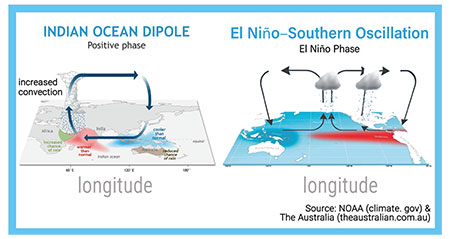Sundarbans Fire: How the Ocean Prompted Blaze
Shahriar Khosnoor Prince
Published: 01 Jun 2024, 11:53 AM

Shahriar Khosnoor Prince
The Sundarbans, a region of immense ecological importance, has been recognised as a UNESCO World Heritage Site in 1987 and designated as a Ramsar site in 2019.
This unique ecosystem, however, faced a devastating fire outbreak on 4 May 2024. According to the Forest Department, at least 25 fire incidents occurred in the past 24 years because of local fishermen burning the roots near the river channels to collect fish in the mud. The real cause of the recent fire incident is yet to be discovered. But, the ocean’s role in spreading the flame is perplexing.
 The ocean is the largest solar heat reservoir on the earth which plays a pivotal role in shaping the world’s weather and climate, both regionally and globally. Variations in the sea surface temperature (SST) drive processes such as evaporation and cloud formation, thereby controlling atmospheric circulation patterns and weather across the globe.
The ocean is the largest solar heat reservoir on the earth which plays a pivotal role in shaping the world’s weather and climate, both regionally and globally. Variations in the sea surface temperature (SST) drive processes such as evaporation and cloud formation, thereby controlling atmospheric circulation patterns and weather across the globe.
The long-term changes in the ocean’s properties ultimately set climate patterns. Given its geographical proximity to the Pacific Ocean and connection with the upper ocean circulation of the Pacific Ocean through the Indonesian Throughflow current along the north of Australia, the Tasman leakage around its south and the Strait of Malacca, the Bay of Bengal’s weather pattern relies heavily on the interaction between the Pacific currents and the Bay’s surface waters, giving rise to complex phenomena such as cyclones and heat waves.
One of the most compelling oceanic phenomena is El Niño, characterised by anomalous warming of surface waters in the central and eastern equatorial Pacific. Its counterpart, La Niña, is the opposite. La Niña is the opposite of El Niño. These two oceanic components, together with the atmospheric counterpart called the Southern Oscillation, give birth to the term El Niño Southern Oscillation (ENSO).
This phenomenon sets off a chain reaction of atmospheric responses across the globe. In the Indian Ocean, El Niño can trigger shifts in atmospheric circulation patterns and affect the regional ocean-atmospheric pattern called the Indian Ocean Dipole (IOD). The IOD cycle is like the Indian Ocean’s version of the ENSO cycle.
In the negative IOD event, the warm waters are pushed to the eastern part of the Indian Ocean, while cold deep waters are brought up to the surface in the western Indian Ocean. Conversely, positive IOD events push the warm waters to the western part of the Indian Ocean, which can intensify monsoon rains over the Bay of Bengal region and increase heat waves in pre-monsoon.
The World Meteorological Organisation (WMO) forecast suggests that the El Niño event had been evident from 2023 to the early months of 2024. During this phase, the Bay of Bengal region experienced irregular precipitation patterns and caused prolonged dry periods accompanied by the phases of an intense heat wave in the summer season. Furthermore, according to the Bureau of Meteorology, Australia (BoM), the Indian Ocean region has indicated a positive IOD cycle since the start of 2024.
The fusion of El Niño and positive IOD has facilitated extreme heat waves during the pre-monsoon period. It will expedite the occurrence of high temperatures and intense rainfall phases during the monsoon. This combined effect has created severe heat wave events in April and May in Bangladesh.
Amidst the different scenarios of climatic variability and the interplays among the influencing patterns, the biggest mangrove in the world faced the harsh consequence of reverberation. The prolonged heat waves led to desiccating soils and leaves and an elevated susceptibility to fires in the Sundarbans.
Relating to the latest incidents, several sources ensured that the abundance of dry leaves in the forest increased the possibility of triggering and spreading the fire. Prolonged heat wave phases without any rain during the pre-monsoon season are not typical for the monsoonal weather pattern of the Bay of Bengal region.
Instead of consistent rainfall, the region faces erratic weather conditions, where extended dry spells are punctuated by intense but brief rainfall. This condition creates a vulnerable situation for starting a forest fire. This might have happened during the fire outbreak of the Sundarbans.
Well, the convergence of oceanic and atmospheric dynamics indicates the need for integrated monitoring and response strategies. Understanding the interplay between the ocean and regional weather systems is necessary for predicting and mitigating such fire risks in future.
Enhanced satellite surveillance, ground-based observation, and traditional knowledge can also be useful for getting early warnings. We must also ensure immediate and responsible information interchange with all the forecasting agencies worldwide.
Forest management authorities can implement preventive measures by anticipating periods of enhanced fire risk. These preventive measures can include controlled burning of the roots near fishing channels and clearing dry roots near localities to reduce the possibility of spreading the fire. Additionally, raising awareness among local communities about the signs of forest fires and the importance of reporting the fire incident immediately can help in early intervention of fire outbreaks. Proactive management based on ocean dynamics and forecasting is essential to protect vital ecosystems like the Sundarbans from future calamities.
_____________________________________
The writer is a Research Officer, Bangladesh Institute of Maritime Research and Development (BIMRAD)

